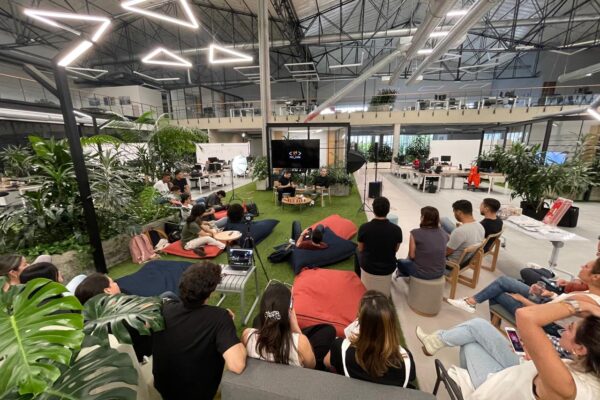Supporting Learning
Supporting learning in a software development company means creating an environment where continuous learning and improvement are integral to the culture. This involves fostering an atmosphere where team members are encouraged to develop new skills, share knowledge, and learn from both successes and failures. A focus on learning leads to higher performance, innovation, and resilience within teams and the organization.
To promote a continuous learning approach, organizations should implement practices and create a culture that encourages and facilitates learning at all levels.
Achieving a continuous learning approach
Here are several strategies and real-life examples of how to achieve this:
Knowledge Sharing Platforms
Implement platforms and tools that facilitate knowledge sharing among team members. This can include internal wikis, documentation, and collaborative tools.
Example: Spotify uses a combination of internal blogs, wikis, and Slack channels to share knowledge and best practices across teams. This helps keep everyone informed and up to date on the latest developments and innovations.
Regular Training, Workshops, Learning Sessions and Talks
Provide regular training, workshops, learning sessions, and talks. Give access to online courses to help employees develop new skills and stay current with industry trends.
Example: Google offers its employees access to a wide range of courses through its internal learning platform, Grow. Employees are encouraged to spend a portion of their workweek on learning and development activities.
Pair Programming and Code Reviews
Encourage pair programming and regular code reviews to facilitate knowledge transfer and improve code quality.
Example: At Pivotal Labs, pair programming is standard practice. Developers work in pairs, rotating regularly, which helps spread knowledge across the team and improves the overall quality of the codebase.
Hackathons and Innovation Days
Organize hackathons and innovation days where employees can work on projects of their choice. This encourages creativity and allows team members to explore new technologies and ideas.
Example: Atlassian hosts ShipIt Days, 24-hour hackathons where employees can work on any project, they are passionate about. This has led to numerous innovations and improvements in their products.
Mentorship Programs
Establish mentorship programs to help junior developers learn from more experienced colleagues. This can accelerate learning and foster a supportive culture.
Example: LinkedIn’s mentorship program pairs junior engineers with senior engineers to provide guidance and support. This helps new hires ramp up quickly and integrate into the company culture.
Encourage Experimentation
Create an environment where experimentation is encouraged, and failures are viewed as learning opportunities. Allow teams to take calculated risks and learn from the outcomes.
Example: Amazon’s “two-way door” decision-making process encourages teams to experiment with new ideas, knowing that most decisions can be reversed if they do not work out. This fosters a culture of innovation and learning.
Continuous Feedback Loops
Implement continuous feedback loops through regular one-on-one meetings, retrospectives, and performance reviews. Use the feedback to identify areas for improvement and opportunities for growth.
Example: Microsoft uses regular check-ins and retrospectives to provide feedback and discuss development goals. This helps employees stay on track and continually improve their skills and performance.
Conclusion
Supporting learning in a software development company is crucial for fostering a high-performance culture that is resilient, innovative, and continuously improving. Organizations can create an environment where continuous learning is deeply ingrained in the culture by implementing practices such as knowledge-sharing platforms, regular training, pair programming, hackathons, mentorship programs, encouraging experimentation, and continuous feedback loops. This not only enhances the skills and capabilities of individual team members but also drives the overall success and competitiveness of the organization.
How do You Assess your Company or Project?
- Learning is invisible or non-existent.
- Learning is a cost. Time for learning is considered unproductive and interferes with real work.
- Learning is budgeted and visible, is considered a perk or is reserved for select resources. Resources have limited ability to choose topics.
- Learning from customers and actual usage of the system is an investment broadly available. Mentoring is supported.
- Learning is continuous. incorporates views from all stakeholders and is encouraged as a normal course of work. Mentoring is seen as a learning practice.
Cultural Capabilities Series
- Cultivating a Performance Oriented Culture
- Effective Team Collaboration: Strategies for High Performance and Success
- How Job Satisfaction Boosts Employee Engagement?
- Unlock the Power of Transformational Leadership
References
- Forsgren, N., Humble, J., & Kim, G. (2018). Accelerate: The Science of Lean Software and DevOps: Building and Scaling High Performing Technology Organizations. IT Revolution Press.
- “Grow with Google: Employee Learning and Development.” Google Careers.
- “Spotify’s Approach to Knowledge Sharing.” Spotify Engineering Blog.
- “Pair Programming at Pivotal Labs.” Pivotal Labs Blog.
- “ShipIt Days at Atlassian.” Atlassian Blog.
- “LinkedIn’s Mentorship Program.” LinkedIn Engineering Blog.
- “Amazon’s Culture of Experimentation.” Amazon Day One Blog.
- “Microsoft’s Continuous Feedback Culture.” Microsoft Careers Blog.
Perficient continually looks for ways to champion and challenge our workforce, encourage personal and professional growth, and celebrate the unique culture created by the ambitious, brilliant, people-oriented team we have cultivated. These are their stories.
Learn more about what it’s like to work at Perficient on our Careers page. Connect with us on LinkedIn here.

